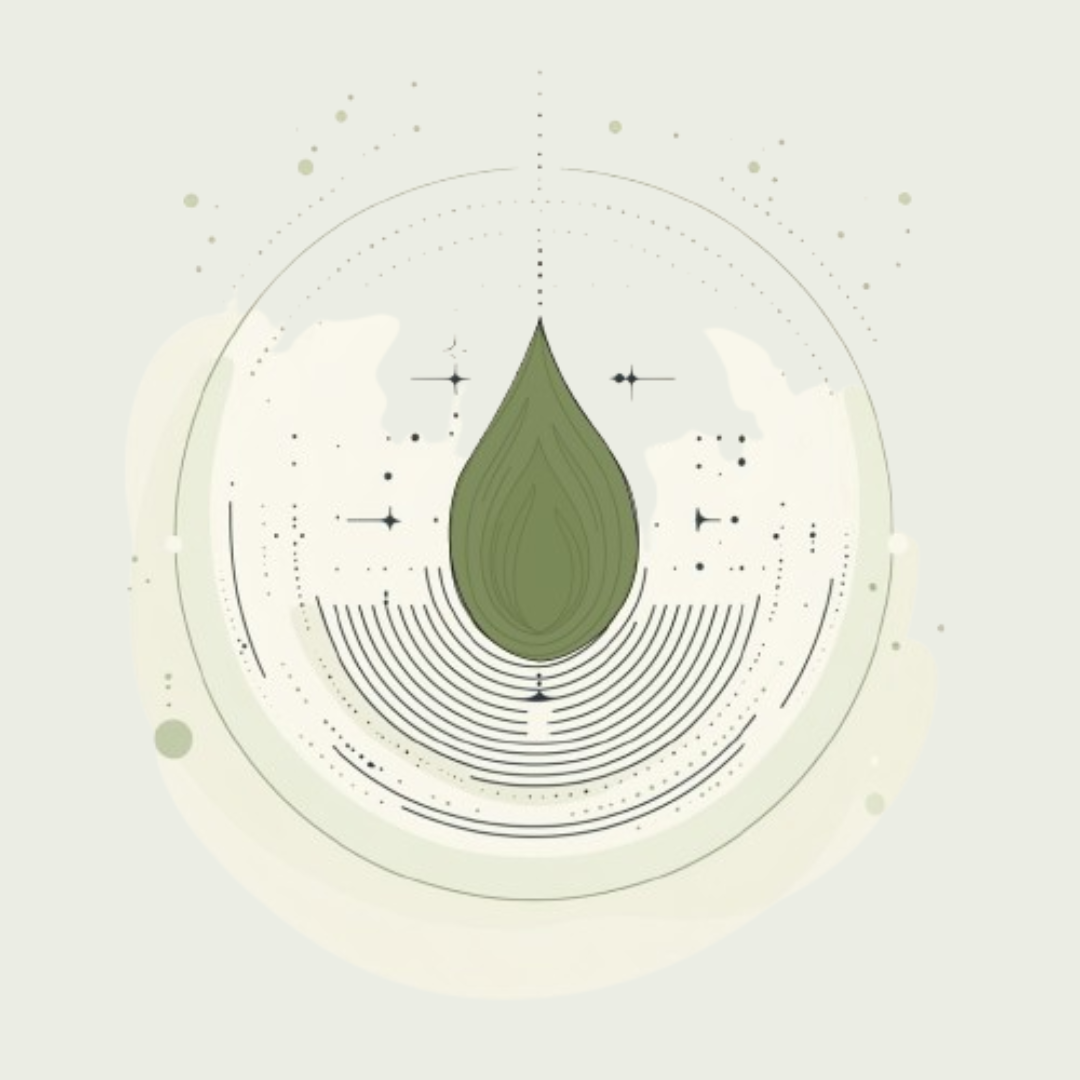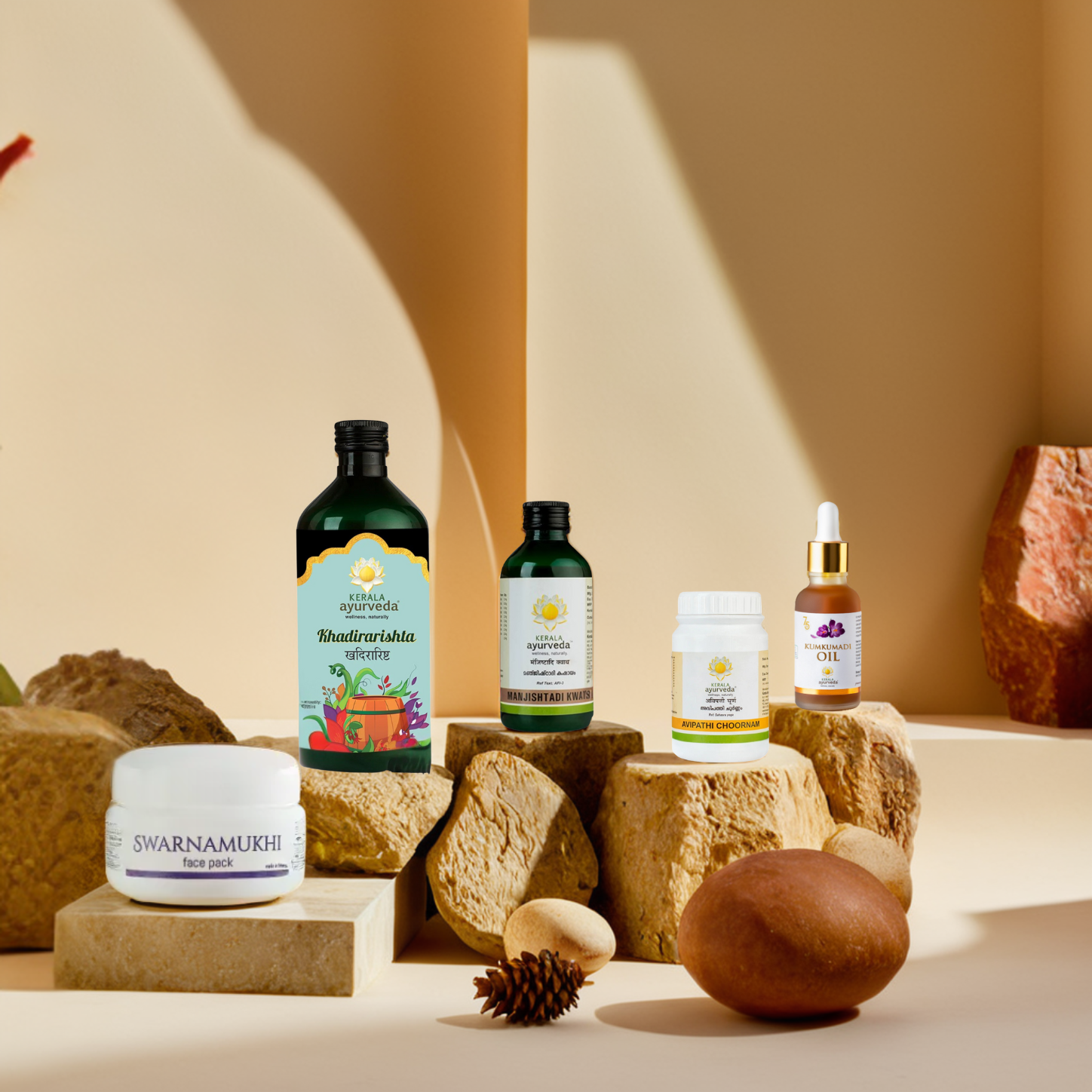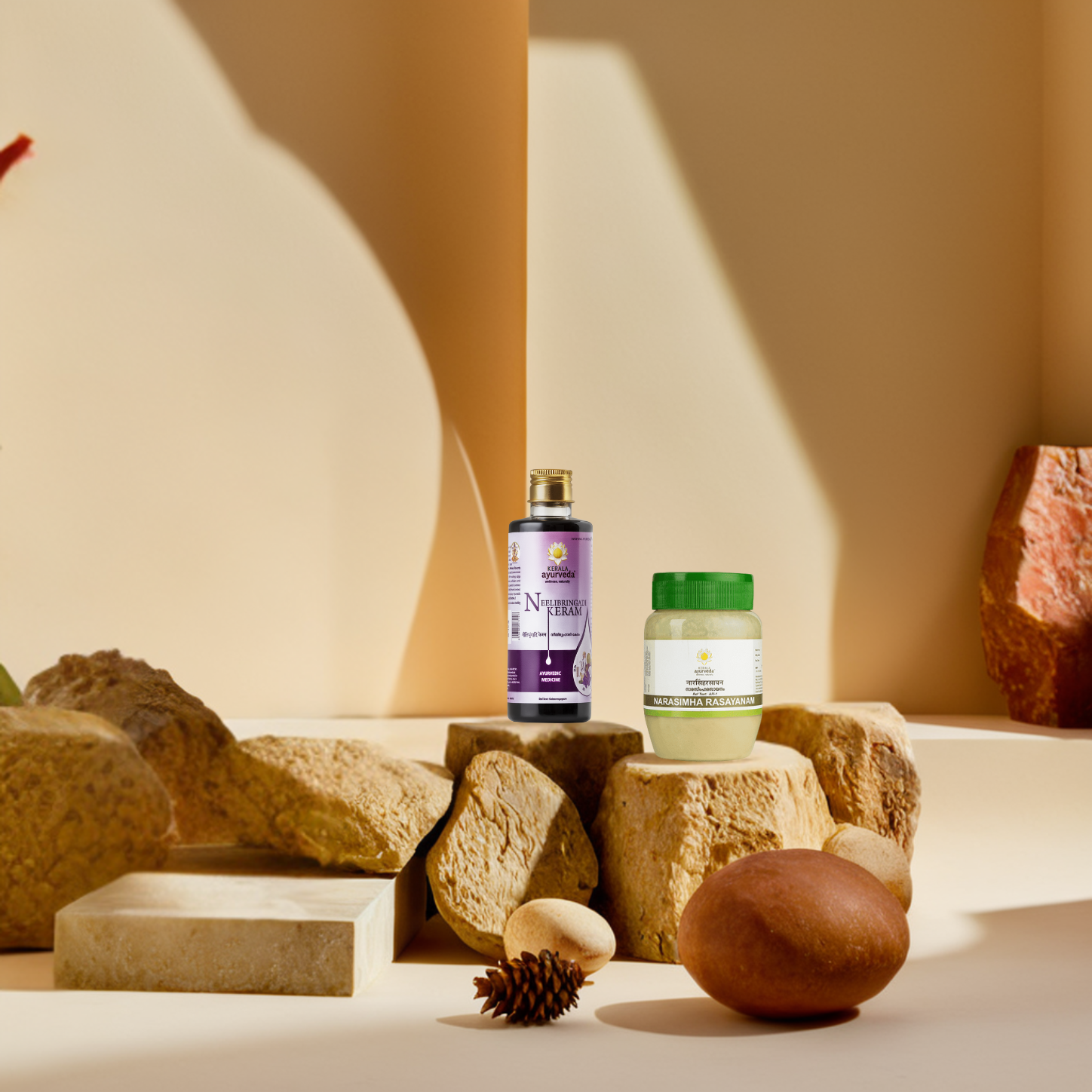Highlights
Complete Guide To Ayurvedic Massages
Tiredness and body pain are two of the most common scenarios occurring at the end of a long day. Whether you work at a desk job, or have a traveling job that requires you to commute a lot - your back, thighs, arms, shoulders, neck and other organs may ache and make you feel tired. In such cases, a rejuvenating Ayurvedic massage can save the day. In this blog, we discuss Ayurvedic massages in detail, throwing light on how you can give yourself a refreshing and relieving Ayurvedic massage. So, let’s delve right in.
Why is massage recommended in Ayurveda?
When your body is feeling pain and fatigue, Ayurvedic massages can help you get relief. Ayurvedic massages are done with medicated herbal oils that have various health benefits. Through the massage procedure, the oils can enter through the skin, reach the tissues (known as Dhatus) and help pace up the repair process.
Apart from that, Ayurvedic oils can have numerous health benefits. Here are some of the key advantages:
- It helps to relieve stress and tension by relaxing the muscles. Massage of the head can assist to relieve headaches.
- It enhances the blood circulation in the region.
- It helps strengthen the skin and make it healthier.
- Regular massages using herbal oils can provide relief from muscular tightness. It may also aid in getting a good night's sleep since it calms the body.
- >When a thorough massage is performed, it nourishes the body and has a renewing impact on it.
The massage is frequently used in various treatments used during Ayurvedic therapy. One of the most prevalent Ayurvedic treatments is panchakarma, which consists of massages. The following are some types of Ayurvedic massages:
Abhyanga : The most common and widely used method of massage, where warm herbal oil is used to massage the entire body. The application of pressure in it during treatment helps to boost the body's energy flow.
Udvartana or Powder massage: To alleviate toxins, a herbal powder is used in the massage.
Kizhi or Potli massage: Herbs cooked in herbal oils or herbal powders are tied in a muslin cloth and massaged over the body.
What is self-massage?
Abhyanga is a full-body massage that helps the body relax. This massage may be done in the comfort of your own home. To reap the full advantages of Abhyanga, massage your own body with an Ayurvedic massage oil. This is referred to as a self-abhyanga. It necessitates the use of an Ayurvedic massage oil. The oil should be carefully rubbed all over the body.
Select the oil before beginning the self-massage. Then choose a time to do the massage. You can follow the below mentioned steps for a good self massage:
- Warm 15-20 ml oil in a bowl by placing it in warm water. To do a head massage or shiro abhyanga, you can use herbal oils such as Neelibringadi keram or Kesini Hair oil and for the body, use Thailams. To protect the floor from oil, you can place an old towel or newspaper. This makes clean-up a breeze later. You'll also reduce your chances of slipping. You may either conduct the massage sitting down on a stool or standing up, depending on your comfort.
- Before beginning the massage, place a few drops in your hand, to check the temperature and start working it in.
- Begin with your head. Dip your fingers in the warm hair oil and massage the scalp in circular strokes. Start with the scalp and work your way up to the hair.
- Earlobes, temples, forehead, cheeks, and chin should all be massaged. Massage this region with your fingertips using a soft touch. After that, take your body massage oil. Work on your neck, shoulders, and arms. Long strokes are beneficial to circulation. On the elbow, use a circular motion. One by one, massage the fingertips
- Massage the chest and abdomen region with your palm. Apply moderate pressure with circular strokes. Move in the direction of food flow while massaging the abdomen. Begin with the big intestine and work your way down.
- Spend some time massaging your thighs and calves. These are often the sources of pain. Massage your knees with circular strokes.Thoroughly massage your feet, including the toes. After that, proceed on to the sole. While massaging the sole, use soft strokes.
- After abhyanga, wait for about 30 minutes so the oil gets absorbed into the skin. You can even do a light exercise and then take a bath in warm water.
Ayurvedic Thailam for Massage
Ayurvedic Thailam is prepared with natural and medicinal herbs, and oils.
Ayurvedic massage therapy is an extremely efficient treatment that can help provide relief from joint discomfort, skin and hair problems, and various other health concerns. Regularly using thailam and practicing Abhyanga can provide long-term relief from numerous health concerns.
Following is a descriptive list of ayurvedic massage oils with their respective benefits:
1. Myaxyl Oil
Myaxyl Oil is an Ayurvedic oil for knee pain, spasms and sprains that contains powerful herbs that help to reduce inflammation and discomfort. This Ayurvedic pain relief oil is made up of substances that have been shown to help with pain and tight muscles and joints. It is a non-sticky, quick absorption, fast relief, pain relief oil that helps relieve sudden onset of knee pain, sore muscles and sports injuries with its powerful blend of herbs like Crepe jasmine or Nandivriksha, Deodar or Devadaru, Lesser galangal or Rasna with Lemongrass oil, Eucalyptus oil along with Tila taila.
2. Ksheerabala Thailam
Ksheerabala thailam helps relieve stress and promotes sleep. Applying Ksheerabala thailam on your palms and soles before going to bed will relieve stress and promote restful sleep. It is made by cooking country mallow or Bala, a strengthening herb cooked in the rich blend of cow’s milk and sesame oil. In Ayurvedic massage therapy, Ksheerabala Thailam massage oil is used to deal with the Vata imbalance.
3. Dhanwantharam Thailam
Dhanwantharam Thailam is the perfect massage oil for expectant and new mothers to helpwith its powerful blend of herbs s ease stress and strengthen the uterus. This doesn't mean it only benefits mothers- it is in fact a complete nourishing oil for men and women alike. Use this oil for your daily abhyanga for a rejuvenating and relaxing experience. It has an exquisite blend of herbs such as Country mallow or Bala, Ginseng or Ashwagandha, Gooseberry or Amla, Indian Bael or Bilva and other herbs processed in sesame oil. Dhanwantharam Thailam is in fact named after Lord Dhanwanthari- the God of Medicine, because of its supreme benefits.
4. Kottamchukkadi Thailam
Kottamchukkadi thailam is the best option for those who are suffering from Tennis elbow or other painful inflammatory conditions due to repetitive wrist movements. Kottamchukkadi thailam with its powerful blend of herbs such as Indian Costus tree or Kottam, a potent anti-inflammatory herb; Dried ginger or Chukk, that warms and relieves pain and stiffness and other herbs cooked in sesame oil; is also an excellent pain relief oil in Cervical spondylosis.
5. Murivenna Thailam
Kerala Ayurveda Murivenna, is a classical quick pain relief Ayurvedic oil is an essential part of your first aid box- it is useful in injuries resulting from athletic activities, overstraining and cuts, burns and wounds. Made with authentic ingredients like betel leaves or Tambula that relieves pain and swelling; drumstick leaves or shigru patra that strengthens joints and other herbs in a soothing coconut oil base, Murivenna is the best solution to sudden onset of sprain and pulled muscle, reduce inflammation and injuries involving pain and swelling.
6. Pinda Thailam
Kerala Ayurveda Pinda thailam is made with natural beeswax and sesame oil, which is then infused with soothing herbs like India madder or Manjistha; Indian Sarsaparilla or Anantamul; and White dammar or Sarja. Manjistha- the name itself translates to “bright red” in Sanskrit. This name acknowledges not only the red-coloured roots but also its deep relationship with blood, as a potent blood purifier. Manjistha roots help balance pitta, which causes pain and burning sensation in Gouty arthritis. Anantamul, which means “the eternal root” in Sanskrit, has cooling and wound healing properties. Sarja is a resin collected from White dammar tree that is cooling in nature. Sesame oil, the base of Pinda thailam , is considered sreshtha or best among thaila or oils, as it suits all dosha types. Natural Beeswax, the key ingredient of Pinda thailam, is a natural anti- inflammatory agent.
7. Balaswagandhadi Thailam
Balaswagandhadi Ayurvedic massage oil is a revitalizing abhyanga oil that helps relieve muscle weakness post infection or illness. With herbs such as country mallow or Bala, the name of which signifies its muscle strengthening properties, ginseng or Ashwagandha thais made with the best herbs collet imparts strength and rejuvenates the body; Balaswagandhadi thailam is ideal to be included in your abhyanga routine to maintain your strength.
8. Sahacharadi Thailam
Kerala Ayurveda Sahacharadi thailam is a pain relief herbal oil for the back that is very useful in katigraha or back pain. It has the presence of several vata balancing herbs that ease pain and improve flexibility. It has ingredients such as Lesser Kurinji or Sahachara, Ten roots or Dashamoola; Indian madder or Manjistha and other 18 herbs; Sesame oil and Milk. Sahachara relieves pain and stiffness of the back. Dashamula literally means ten roots in Sanskrit. It is the combination of ten herbal roots excellent in balancing Vata. Manjistha helps reduce swelling. These and other vata balancing herbs are cooked along with milk and pain relieving sesame oil, to yield Sahacharadi thailam. Kerala Ayurveda Sahacharadi thailam is made with the best herbs collected from our herbal gardens and other authentic sources. These are then cooked in the same way as mentioned in the vedas, to yield the original Sahacharadi thailam.
9. Mahanarayana Thailam
Kerala Ayurveda Mahanarayana thailam, named after Narayana or Lord Vishnu, is an abhyanga oil for relaxing sore muscles after your exercise routines. It strengthens the muscles and rejuvenates them, making you ready for action, faster! Kerala Ayurveda Mahanarayana thailam is also an arthritis pain relief oil that helps ease stiffness and pain associated with osteoarthritis. It has a nourishing blend of herbs that provides a sense of comfort and relief.
10. Mahamasha Thailam
Mahamasha Thailam can help relieve numbness and strengthen nerves. It has herbs such as black gram or masha and ten roots or Dashamoola, that helps balance vata dosha.




